What Causes Laminitis?
This is actually a VITAL question which needs to be asked in every case of laminitis.
There are many factors that could cause laminitis. Despite the name, only certain types of laminitis are truly ‘inflammatory’, and in fact the most common type of laminitis developing from metabolic disease is not really inflammatory at all.
In the past laminitis was treated as a disease process and treatment only focussed on the clinical signs of laminitis. Of course, this is important, but we now know that most cases of laminitis are a clinical sign of disease elsewhere – either severe systemic inflammatory disease or a metabolic condition.
There are 3 main causes of laminitis: Overload, Inflammatory and Metabolic.
Overload Laminitis
Relatively less commonly, horses can get laminitis from overload, typically associated with non-weight bearing conditions in one limb thereby overloading the opposite limb. The most famous example of this was the American racehorse Barbaro who had a bone fracture in one hind limb which was successfully fixed, but he unfortunately succumbed to laminitis in the other hind limb, ultimately resulting in him being euthanased.
When horses have severe non-weight bearing conditions we are very aware of the risk to the other foot and so we will usually support the weight bearing limb as much as possible (Figure 1).
Inflammatory Laminitis
A typical form of laminitis caused by inflammatory disease is grain overload – horses usually have to eat at least 4 kg of straight starch-rich grain in one go, with the amount required to cause disease lower in horses that are not accustomed to eating a lot of grain. When this happens, the grain is only partly digested, builds up in the hind gut where rapid fermentation causes massive changes in the gut, ultimately resulting in gut damage, absorption of toxins and severe diarrhoea and illness (Figure 2).
Other causes include less common conditions including: difficult colics where the gut is severely damaged, colitis (diarrhoea) and also septic conditions like pleuropneumonia and retained placenta (afterbirth) (Figure 3).
Common to all of these is severe systemic illness and absorption of toxins into the blood which have far reaching effects in the lamellae of the hoof.
Metabolic Laminitis
Metabolic causes include pituitary pars intermedia dysfunction (PPID; Cushing’s disease) and equine metabolic syndrome (EMS) – these are two diseases where horses have abnormal control of their carbohydrate metabolism and as a result have abnormally high levels of the hormone insulin. The abnormal processing of dietary carbohydrates in both of these conditions involves an excessive insulin response to starches (main carbohydrate in grains) or sugars (main carbohydrates in grasses and hay) in horse feed (Figure 4).
PPID and EMS are not the same though!
PPID
PPID is a disease of ageing, where the control of pituitary gland hormone secretion is lost, leading to excessive secretion from a certain part of the gland (the pars intermedia, as in PPID). If a horse has this condition, there may be a variety of clinical signs which may include: a long hair coat due to delayed shedding, sweating, loss of muscle mass, development of a pot belly and drinking excessively (Figure 5). Some of the hormones produced from the pituitary also affect carbohydrate metabolism and can predispose to laminitis.
Many PPID horses/ponies may have been originally fat, so when they lose muscle their fat often looks strange and lumpy, but PPID is not caused by obesity.
For those of you keen to read more about PPID we have an open access paper which was written for vets by researchers and clinicians at the University of Liverpool but may provide some good insight into PPID to the general reader.
EMS
EMS (or equine metabolic syndrome) tends to occur in genetically predisposed breeds (especially native ponies), and is worsened by obesity (Figure 6). This does not mean that all obese horses or ponies have EMS, but if the horse or pony has EMS then obesity will worsen the carbohydrate metabolism and predispose to laminitis (Figure 4).
For those of you keen to read more about EMS, clinician researchers at the Universities of Edinburgh and Liverpool teamed up to produce an open access review paper which was written for vets but may provide some good insight into EMS for the general reader.
Why is Knowing the Cause of Laminitis Important?
As you can see, knowing the cause is essential in order to avoid the events causing laminitis and also to prevent future episodes of laminitis. Also, the different causes of laminitis may need different types of care.
Overload laminitis cases will need to be treated by supporting the limbs with the aim of correcting the cause of the overload. Inflammatory causes will be treated by intensive medical care, but metabolic cases will need diagnosis and treatment of often quite longstanding endocrine conditions. Therefore, it is important to seek advice from a vet in order to work out the best treatment and care plan.
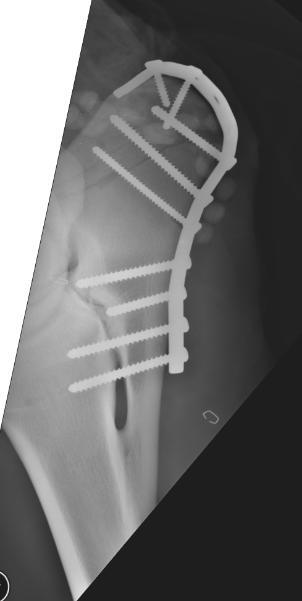
Figure 1 - Any condition that causes a horse to be unable to put weight on one leg (such as this horse with the fracture of its elbow – subsequently repaired as in the x ray shown) can result in overload laminitis in the opposite leg
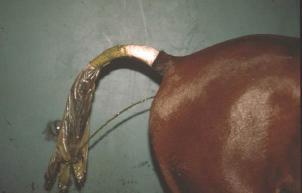
Figure 2 - Severe diarrhoea in horses (colitis) may result in laminitis
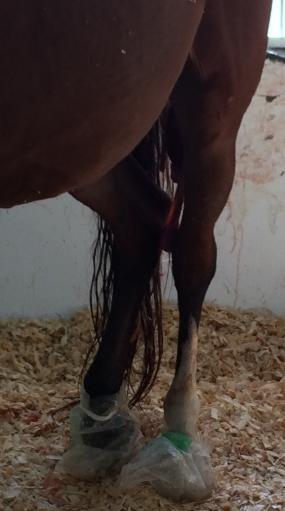
Figure 3 - Retained afterbirth in mares is a risk factor for systemic illness and inflammatory laminitis. This mare has had ice placed around her feet to help prevent laminitis from developing.
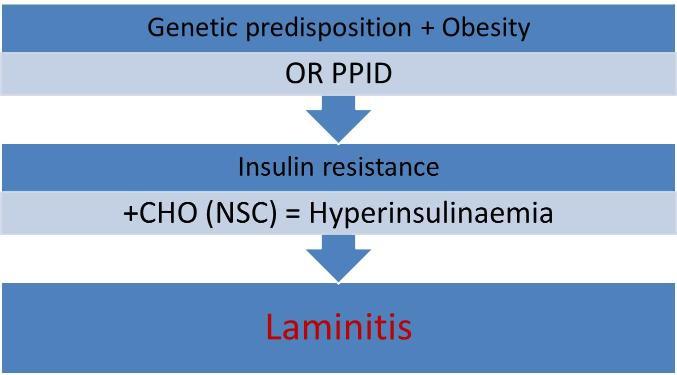
Figure 4 - The relationship between insulin and laminitis – horses with a genetic predisposition to EMS (with increased risk if also fat) or with PPID will develop insulin resistance. Horses with insulin resistance that eat high carbohydrate [CHO] diets (e.g. high starch in grain diets or high sugars [non-structural carbohydrates; NSC] in rich pasture or good quality hay diets) develop high insulin [hyperinsulinaemia] which causes laminitis
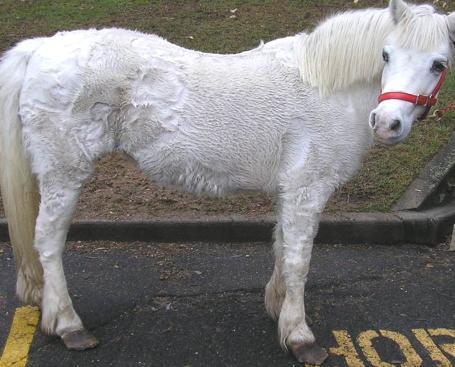
Figure 5 - Horse with PPID – note clinical signs including laminitis (note also the many rings on the hooves), wasting (loss of topline), sweating, bulging above the eyes and a long haircoat that has not shed properly (hypertrichosis)
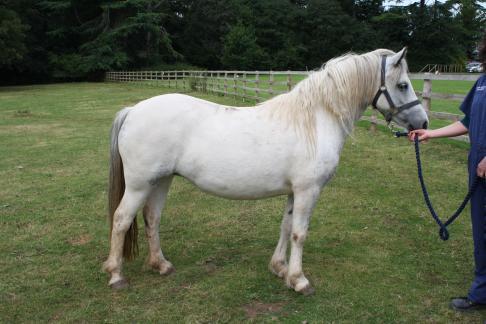
Figure 6 - Typical native type pony carrying excess body weight during the spring and summer